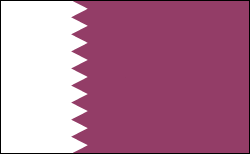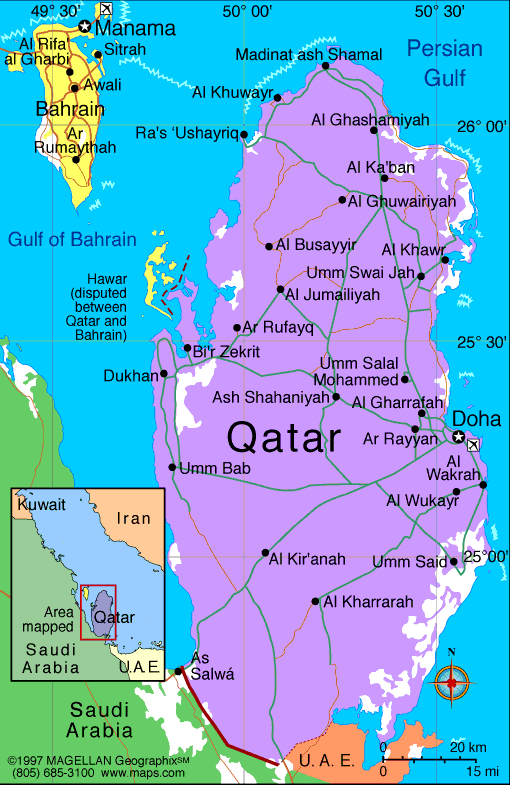QATAR

Geography: Qatar (pronounced KAH-ter) occupies a small peninsula that extends into the Persian Gulf from the east side of the Arabian Peninsula. Saudi Arabia is to the west and the United Arab Emirates to the south. The country is mainly barren.
Government: Constitutional monarchy.
History: Qatar was once controlled by the sheikhs of Bahrain, but in 1867, war broke out between the people and their absentee rulers. To keep the peace in the Persian Gulf, the British installed Muhammad ibn Thani al-Thani, head of a leading Qatari family, as the region's ruler. In 1893, the Ottoman Turks made incursions into Qatar, but the emir successfully deflected them. In 1916, the emir agreed to allow Qatar to become a British protectorate.
Oil was discovered in the 1940s, bringing wealth to the country in the 1950s and 1960s. About 85% of Qatar's income from exports comes from oil. Its people have one of the highest per capita incomes in the world. In 1971, Qatar was to join the other emirates of the Trucial Coast to become part of the United Arab Emirates. But both Qatar and Bahrain decided against the merger and instead formed independent nations.
Qatar permitted the international forces to use Qatar as a base during the 1991 Persian Gulf War. A border dispute erupted with Saudi Arabia that was settled in Dec. 1992. A territorial dispute with Bahrain over the Hawar Islands remains unresolved, however. In 1994, Qatar signed a defense pact with the U.S., becoming the third Gulf state to do so.
In June 1995, Crown Prince Hamad bin Khalifa al-Thani deposed his father, primarily because the king was out of step with the country's economic reforms. The emir was not stripped of his title, and much of the power was already in his son's hands. The new emir lifted press censorship and instituted other liberal reforms, including democratic elections and women's suffrage (1999). In 2003 Crown Prince Jassim, who declared he had never wanted to be king, abdicated in favor of his younger brother, Prince Tamim.
Qatar is the home of Al Jazeera, the immensely popular and controversial Arabic satellite television network.
Qatar introduced its first constitution on June 9, 2005. It guarantees freedom of expression, assembly, and religion and calls for a 45-seat parliament. Thirty of the seats will be filled in democratic elections; the emir will appoint the remaining seats.
Sheik Abdullah bin Khalifa Al Thani resigned as prime minister in April 2007. The emir named former foreign minister Sheik Hamad bin Jassem al Thani as his replacement.
On June 25, 2013, Emir Sheikh Hamad ibn Khalifah Al Thani abdicated the throne. His fourth son, Sheikh Tamim bin Hamad bin Khalifa Al Thani, age 33, succeeded him as emir. Sheikh Tamim bin Hamad bin Khalifa Al Thani appointed his cabinet, including Sheikh Abdullah ibn Nasser ibn Khalifah Al Thani as the new prime minster.
Government: Constitutional monarchy.
History: Qatar was once controlled by the sheikhs of Bahrain, but in 1867, war broke out between the people and their absentee rulers. To keep the peace in the Persian Gulf, the British installed Muhammad ibn Thani al-Thani, head of a leading Qatari family, as the region's ruler. In 1893, the Ottoman Turks made incursions into Qatar, but the emir successfully deflected them. In 1916, the emir agreed to allow Qatar to become a British protectorate.
Oil was discovered in the 1940s, bringing wealth to the country in the 1950s and 1960s. About 85% of Qatar's income from exports comes from oil. Its people have one of the highest per capita incomes in the world. In 1971, Qatar was to join the other emirates of the Trucial Coast to become part of the United Arab Emirates. But both Qatar and Bahrain decided against the merger and instead formed independent nations.
Qatar permitted the international forces to use Qatar as a base during the 1991 Persian Gulf War. A border dispute erupted with Saudi Arabia that was settled in Dec. 1992. A territorial dispute with Bahrain over the Hawar Islands remains unresolved, however. In 1994, Qatar signed a defense pact with the U.S., becoming the third Gulf state to do so.
In June 1995, Crown Prince Hamad bin Khalifa al-Thani deposed his father, primarily because the king was out of step with the country's economic reforms. The emir was not stripped of his title, and much of the power was already in his son's hands. The new emir lifted press censorship and instituted other liberal reforms, including democratic elections and women's suffrage (1999). In 2003 Crown Prince Jassim, who declared he had never wanted to be king, abdicated in favor of his younger brother, Prince Tamim.
Qatar is the home of Al Jazeera, the immensely popular and controversial Arabic satellite television network.
Qatar introduced its first constitution on June 9, 2005. It guarantees freedom of expression, assembly, and religion and calls for a 45-seat parliament. Thirty of the seats will be filled in democratic elections; the emir will appoint the remaining seats.
Sheik Abdullah bin Khalifa Al Thani resigned as prime minister in April 2007. The emir named former foreign minister Sheik Hamad bin Jassem al Thani as his replacement.
On June 25, 2013, Emir Sheikh Hamad ibn Khalifah Al Thani abdicated the throne. His fourth son, Sheikh Tamim bin Hamad bin Khalifa Al Thani, age 33, succeeded him as emir. Sheikh Tamim bin Hamad bin Khalifa Al Thani appointed his cabinet, including Sheikh Abdullah ibn Nasser ibn Khalifah Al Thani as the new prime minster.

Map of Qatar
Emir: Sheikh Tamim ibn Hamad Al Thani (2013)
Prime
Minister: Sheikh Abdullah ibn Nasser ibn Khalifah Al Thani (2013)
Total area: 4,416 sq mi (11,437 sq
km)
Population (2014 est.): 2,123,160
(growth rate: 3.58%); birth rate: 9.95/1000; infant mortality rate:
6.42/1000; life expectancy: 78.38; density per sq mi: 455
Capital (2011 est.):
Doha, 567,000
Monetary unit: Qatari
riyal
National name:
Dawlat Qatar
Languages:
Arabic (official); English a common second
language
Ethnicity/race:
Arab 40%, Pakistani 18%, Indian 18%, Iranian
10%, other 14%
Religion:
Religion Muslim 77.5%, Christian 8.5%, other 14%
(2004 census)
Literacy rate: 96.3%
(2010)
Economic summary:
GDP/PPP (2013 est.): $198.7 billion; per capita $102,100.
Real growth rate: 5.5%. Inflation: 3.1%.
Unemployment: 0.3%. Arable land: 1.21%.
Agriculture: fruits, vegetables; poultry, dairy products, beef;
fish. Labor force: 1.424 million (2013 est.). Industries:
liquefied natural gas, crude oil production and refining,
ammonia, fertilizers, petrochemicals, steel reinforcing bars, cement,
commercial ship repair. Natural resources: petroleum, natural gas, fish.
Exports: $12.7 billion (2013 est.): liquefied natural
gas (LNG), petroleum products, fertilizers, steel. Imports:
$39.58 billion (2011 est.): machinery and transport
equipment, food, chemicals. Major trading partners: Japan,
South Korea, Singapore, India, Italy, China, France, U.S., Saudi Arabia, UAE,
Germany, UK (2013).
Communications:
Telephones: main lines in use: 327,000 (2012); mobile cellular:
2.6 million (2012). Radio broadcast stations: AM 6, FM 5, shortwave
1 (1998). Radios: 256,000 (1997). Television broadcast
stations: 1 (2014). Televisions:
230,000 (1997). Internet Service Providers (ISPs): 897 (2012).
Internet users: 563,800 (2009).
Transportation: Railways: 0 km. Highways:
total: 9,830 km (2010).
Ports and harbors: Doha, Mesaieed (Umaieed), Ra's Laffan.
Airports: 6 (2013).
International
disputes: none.
-------------------- o --------------------
No comments:
Post a Comment